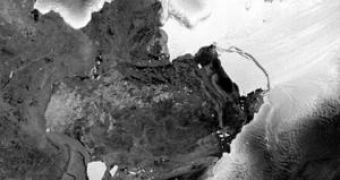A large iceberg has just split off from Pine Island Glacier in Antarctica. Envisat's Advanced Synthetic Aperture Radar (ASAR) instrument monitored the cleavage of the huge ice mass, 34 km in length and 20 km in width, having an area nearly half the size of Greater London.
Icebergs appear due to the action of winds and waves, as the ice shelf expends too much to support part of itself, or through collision with an older iceberg.
As Pine Island Glacier was already floating before the cleavage (it was an ice shelf), it will not provoke any rise in the world sea level.
Iceberg calving takes place annually in Antarctica, in the natural cycle of the ice sheet. A huge iceberg appears every 5-10 years, the previous one being formed in 2001.
Pine Island represents the largest ice mass in the West Antarctic Ice Sheet (WAIS), carrying 10 % of its ice from the deep interior of the WAIS into the ocean. Researchers are worried because its speed went up over the past 15 years. The Pine Island Glacier has a thickness of 2500 m (1.5 mi) with a bedrock over 1500 m below sea level.
ESA's ERS satellite information revealed a loss of 31-cubic km of ice from the WAIS' interior between 1992 and 2001 in the Pine Island Glacier. The glacier lost 5 km of its length and this suggests the fact that small changes at the shores of the Antarctica, connected to global warning, could have a rapid inland effect resulting into a more rapid rise of the sea level.
Still, the novel iceberg in itself is a normal phenomenon. Over the last 15 years, the ice shelf front has moved forward into the sea at a rhythm of 3 km (1.8 mi)/year, so the removal of this huge ice mass has just turned the ice line back to where it was after the last large iceberg break off in 2001.

 14 DAY TRIAL //
14 DAY TRIAL //